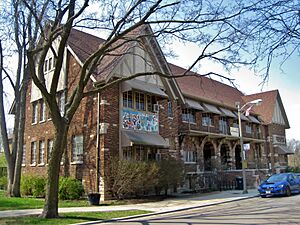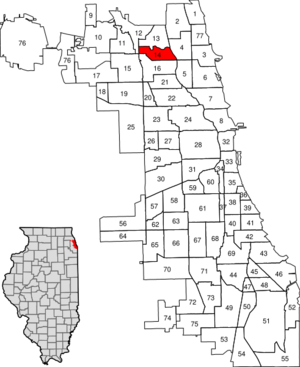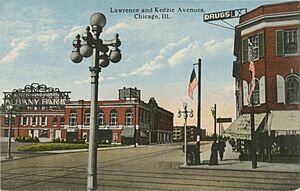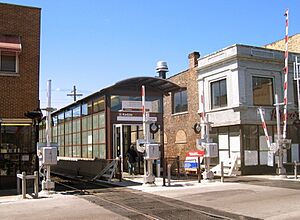Albany Park, Chicago facts for kids
Quick facts for kids
Albany Park
|
|
|---|---|
| Community Area 14 - Albany Park | |

Eugene Field Park house
|
|

Location within the city of Chicago
|
|
| Country | United States |
| State | Illinois |
| County | Cook |
| City | Chicago |
| Neighborhoods |
list
|
| Area | |
| • Total | 1.93 sq mi (5.00 km2) |
| Population
(2020)
|
|
| • Total | 48,396 |
| • Density | 25,069/sq mi (9,679/km2) |
| Demographics 2018-2022 | |
| • White | 33.6% |
| • Black | 4.2% |
| • Hispanic | 44.2% |
| • Asian | 14.8% |
| • Other | 3.1% |
| Educational Attainment 2019 | |
| • High School Diploma or Higher | 80% |
| • Bachelor's Degree or Higher | 37% |
| Time zone | UTC-6 (CST) |
| • Summer (DST) | UTC-5 (CDT) |
| ZIP Codes |
parts of 60625, 60630
|
| Median household income 2019 | $61,759 |
| Source: U.S. Census, Record Information Services | |
Albany Park (![]() i/ˈɔːlbəni/ awl-BƏ-nee) is one of 77 special areas in Chicago. It's located on the Northwest Side of the city. The North Branch of the Chicago River forms its eastern and northern edges.
i/ˈɔːlbəni/ awl-BƏ-nee) is one of 77 special areas in Chicago. It's located on the Northwest Side of the city. The North Branch of the Chicago River forms its eastern and northern edges.
Albany Park is known for being very diverse. It has one of the highest numbers of people born in other countries compared to other Chicago neighborhoods. Many residents come from Latin America, especially Mexico, Guatemala, and Ecuador. There are also many people from the Philippines, India, Korea, Cambodia, Somalia, and countries in Europe and the Middle East. More than 40 different languages are spoken in its public schools!
Because so many different people moved here, the number of residents in Albany Park grew by 16.5% during the 1990s.
Contents
Exploring Albany Park's Past
The Albany Park area was first settled in 1893. At that time, several investors bought land here because areas closer to downtown Chicago were getting very crowded. DeLancy Louderback, who was from Albany, New York, was one of these investors. He chose the name "Albany Park" for the new community.
To help people get around, electric streetcars were added in 1896. Later, in 1907, the Northwestern Elevated Railroad extended its train line to the Kimball terminal. This made it much easier to travel to and from Albany Park. Because of this new transportation, many new buildings were built in the area.
Back then, the North Branch of the Chicago River had many twists and turns. The Chicago Sanitary District straightened the river. This helped to clearly define property lines and improve the sewage system in Albany Park.
By 1930, about 55,000 people lived in Albany Park. Many schools, churches, and parks opened to serve the growing community. Haugan Elementary School became the largest elementary school in Chicago. Roosevelt High School became so crowded that another school, Von Steuben Elementary, was turned into a high school.
After World War II, some residents started moving to the northern suburbs. The population went down, and some stores and properties became empty. But in the 1970s, new groups of immigrants began to arrive, mainly from Asia (like Korea) and Central America. This new wave of people helped the population grow again. Today, Albany Park is known as one of the most diverse neighborhoods in Chicago and even in the entire country.
Discovering Albany Park's Neighborhoods
Albany Park is made up of several smaller neighborhoods. Here are the main ones:
- Albany Park: This part is bordered by the North Branch of the Chicago River to the north and east. Montrose Avenue is to the south, and Pulaski Road is to the west.
- Mayfair: This area is between Lawrence Avenue (north) and Cullom Avenue (south). Pulaski Road is to the east, and Lamon Avenue is to the west.
- North Mayfair: This neighborhood is north of Mayfair, between Bryn Mawr Avenue (north) and Lawrence Avenue (south). Pulaski Road is to the east, and Lamon Avenue is to the west.
- Ravenswood Manor: This neighborhood is bordered by Lawrence Avenue (north) and Montrose Avenue (south). The Chicago River is to the east, and Sacramento Avenue is to the west.
Just north of Albany Park, in North Park, you can find Northeastern Illinois University and North Park University.
Korean Culture in Albany Park
In the 1980s, Albany Park became known as "Koreatown" in Chicago. Many Korean shops were located on Lawrence Avenue, between Kedzie Avenue and Pulaski Road. This part of Lawrence Avenue is even officially called "Seoul Drive" by the city because of all the Korean-owned businesses there.
Even though many Korean Americans have moved to northern suburbs like Niles and Glenview in recent years, Albany Park still has a strong Korean feel. There's a Korean festival every year, a Korean radio station (1330 AM), and two Korean-language newspapers. You can still find many Korean businesses alongside newer Mexican bakeries and Middle Eastern grocery stores.
Albany Park's Population Story
| Historical population | |||
|---|---|---|---|
| Census | Pop. | %± | |
| 1930 | 55,577 | — | |
| 1940 | 56,692 | 2.0% | |
| 1950 | 52,995 | −6.5% | |
| 1960 | 49,450 | −6.7% | |
| 1970 | 47,092 | −4.8% | |
| 1980 | 46,075 | −2.2% | |
| 1990 | 49,501 | 7.4% | |
| 2000 | 57,655 | 16.5% | |
| 2010 | 51,542 | −10.6% | |
| 2020 | 48,396 | −6.1% | |
After the area became part of Chicago, German and Swedish farmers were among the first immigrants to settle here. Many built their own homes. In the early 1900s, more Jewish families moved to Albany Park. They came from crowded areas closer to downtown Chicago. After World War II, some of these families began moving to northern suburbs like Skokie.
Starting in the 1970s, new immigrants from Asia (like Korea) and Latin America (like Guatemala) began moving into the neighborhood. Immigration continued from all over the world. By the 1990s, there were large groups of people from the Philippines, Iran, Iraq, Lebanon, Poland, Vietnam, Burma, Cambodia, Mexico, Ecuador, and Colombia. After a war in Yugoslavia (1992-1995), many Serbians and Bosnians also moved to Albany Park. In the 2000s, the western part of the neighborhood welcomed many Indian and East African immigrants.
As of 2019, Albany Park has about 49,806 residents. The community is very diverse, with people from many different backgrounds.
Getting Around Albany Park
You can get to Albany Park using Chicago's public transportation. The Brown Line train ends at Lawrence and Kimball Avenues. You can use the Kimball, Kedzie, and Francisco stations on the Brown Line. The nearby Montrose Blue Line station is also close. If you're driving, the Edens expressway (Interstate 94) is also nearby.
Metra's Milwaukee District/North Line also has a train station in the Mayfair area of Albany Park.
Several CTA bus routes serve Albany Park, including: 53 Pulaski, 78 Montrose, 81 Lawrence, 82 Kimball-Homan, 92 Foster, and 93 California/Dodge.
Schools in Albany Park
Albany Park has many schools for students of all ages.
- Public Schools - Chicago Public Schools runs these schools
- Hibbard Elementary School
- Haugan Elementary School
- Budlong Elementary School
- Newton Bateman Elementary School
- North River Elementary
- Waters Elementary
- Volta Elementary
- Chappell Elementary
- ASPIRA at Haugan Middle School
- Haugan Middle Campus
- Albany Park Multicultural Academy
- Roosevelt High School
- Von Steuben Metropolitan Science Center
- Edison Regional Gifted Center
- Global Village
- John M. Palmer Elementary
- Private Schools
- North Shore Junior Academy
- Little Angels
- Telshe Yeshiva
- Gateway to Learning
- St. Matthias Transfiguration
- St. Edward School
- Eagle's Wings Urban Academy
- Universities
- Northeastern Illinois University
- North Park University
Parks and Fun Places
Albany Park has many parks and recreation spots where you can play and relax:
- Buffalo Playlot Park
- Eugene Field Park
- Gompers Park
- Jensen Park
- Kiwanis Park
- LaPointe Park
- North Mayfair Playlot Park
- Ravenswood Manor Park
- River Park
- Ronan Park
Local Culture
The Chicago Shimpo, a Japanese-language newspaper, used to have its offices in Albany Park. It is now located in Arlington Heights.
Community Gardens
Albany Park is home to several community gardens where people can grow plants and vegetables:
- Jensen Community Gardens
- Drake Community Garden
- Turtle Park Community Garden
- Global Gardens Community Garden
- Global Garden Refugee Training Farm
Community Groups and Organizations
Many groups work to make Albany Park a better place. Here are some of them:
- Albany Park Autonomous Center
- Carole Robertson Center for Learning (formerly Albany Park Community Center)
- Albany Park Chamber of Commerce
- Albany Park Neighbors
- Albany Park Theater Project
- American Indian Center
- American Legion
- Anthem Church
- Autonomous Tenants Union
- Cambodian Association of Illinois
- Christ Church
- Church of the Beloved Albany Park
- Communities United (formerly Albany Park Neighborhood Council)
- Foresight Design Initiative
- Friedman Place
- Full Gospel Chicago Church
- Hanul Family Alliance
- Healthy Albany Park Coalition
- Irish American Heritage Center
- King Oscar Lodge
- Korean American Community Services
- Latino Union Worker Center
- Lawrence Avenue Development Corporation
- Lawrence Hall Youth Services
- Mayfair Civic Organization
- Mexico-US Solidarity Network
- New Life Community Church
- North Branch Projects
- North Mayfair Improvement Association
- North River Commission
- People of East Albany Park (PEAP) neighborhood organization
- Ravenswood Manor Improvement Association
- River Park Advisory Council
- Svithiod Independent Order
- Territory Albany Park
- True North Christian Fellowship
- Young Women's Empowerment Project
- West River Park Improvement Association
- West River Park Neighbors
- World Relief Chicago
Famous People from Albany Park
Many notable people have lived in or have connections to Albany Park:
- Rod Blagojevich (born 1956): He was the 40th Governor of Illinois from 2003 to 2009. He has lived in Albany Park since 1999, except for a period of time when he was away.
- Patti Blagojevich (born 1965): She was the First Lady of Illinois from 2003 to 2009 and also lives in Albany Park.
- Neil Bluhm (born 1938): A very successful businessman in real estate and casinos. He grew up in Albany Park.
- Nancy Faust (born 1947): She was the organist for the Chicago White Sox baseball team for many years (1970-2010). She went to Theodore Roosevelt High School and North Park University.
- Neal Gabler (born 1950): A journalist, writer, and film critic who lived in Albany Park as a child.
- Carl Giammares: A singer and member of the band The Buckinghams.
- Cecil Heftel (1924–2010): A member of the United States House of Representatives from Hawaii. He grew up in Albany Park and went to Roosevelt High School.
- Randy Jackson (1926–2019): A professional baseball player who lived in Ravenswood Manor when he played for the Chicago Cubs.
- Alaric Jans (born 1949): A composer for films and theater. He used to be the president of the Ravenswood Manor Improvement Association.
- Jerry Krause (1939–2017): The general manager of the Chicago Bulls basketball team from 1985 until 2003. He grew up in Albany Park.
- Sid Luckman (1916–1998): A famous American football quarterback for the Chicago Bears. He lived in Ravenswood Manor.
- Fred Pfeffer (1860–1932): A professional baseball player who lived in Ravenswood Manor.
- Elroy Sandquist Sr. (1899–1970): A member of the Illinois House of Representatives.
- Elroy Sandquist Jr. (1922–1996): Also a member of the Illinois House of Representatives.
- Abe Saperstein (1902-1966): The person who founded, coached, and owned the famous Harlem Globetrotters basketball team.
- Bob Sirott (born 1949): A well-known broadcaster.
- Sam Zell (1941–2023): A billionaire and founder of Equity International. He lived in Albany Park until his family moved when he was twelve.



